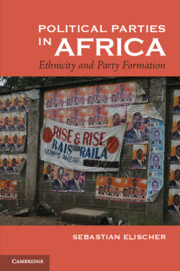Book contents
- Frontmatter
- Dedication
- Contents
- Tables
- Abstract
- Acknowledgments
- 1 Comparative Politics and Political Parties in Africa
- 2 A New Framework of Comparison for Political Parties
- 3 Kenya: The Ubiquity of Ethnic Parties
- 4 Namibia: The Dominance of Nonethnic Parties
- 5 Ghana: The Ubiquity of Nonethnic Parties
- 6 The Diversity of African Party Politics
- 7 Explaining the Formation of Nonethnic Parties
- Conclusion
- Annex A Operationalization of Secondary Party Types
- Annex B The Standard MRG Coding Frame
- Annex C Number of Effective Programmatic Categories
- Annex D Summary of Party Nationalization Scores (PNS) and Party Divergence Scores (PDS)
- Annex E Result for MRG Coding Scheme
- Annex F PNS Calculated on the Basis of Afrobarometer Data
- Annex G Scope of Party Systems Covered
- Annex H Party Nationalization Scores (PNS) of the Preliminary Cases
- Bibliography
- Index
3 - Kenya: The Ubiquity of Ethnic Parties
Published online by Cambridge University Press: 05 June 2014
- Frontmatter
- Dedication
- Contents
- Tables
- Abstract
- Acknowledgments
- 1 Comparative Politics and Political Parties in Africa
- 2 A New Framework of Comparison for Political Parties
- 3 Kenya: The Ubiquity of Ethnic Parties
- 4 Namibia: The Dominance of Nonethnic Parties
- 5 Ghana: The Ubiquity of Nonethnic Parties
- 6 The Diversity of African Party Politics
- 7 Explaining the Formation of Nonethnic Parties
- Conclusion
- Annex A Operationalization of Secondary Party Types
- Annex B The Standard MRG Coding Frame
- Annex C Number of Effective Programmatic Categories
- Annex D Summary of Party Nationalization Scores (PNS) and Party Divergence Scores (PDS)
- Annex E Result for MRG Coding Scheme
- Annex F PNS Calculated on the Basis of Afrobarometer Data
- Annex G Scope of Party Systems Covered
- Annex H Party Nationalization Scores (PNS) of the Preliminary Cases
- Bibliography
- Index
Summary
Kenya is as the first country to which the amended Diamond and Gunther (2001 and 2003) party typology is applied. Kenyan parties are representative of the typology's ethnic party types. All parties under scrutiny are classified as mono-ethnic or multiethnic alliances. The dynamics of political party competition in Kenya are thus in line with the assumption that multiparty competition in new democracies leads to ethnic conflict and violence. Those who have a pessimistic outlook on the chances of democratic transitions in Africa frequently refer to the political dynamics of Kenyan party politics. However, over time, Kenyan parties try to become nonethnic parties. Although they fail to become national parties, they are undergoing a transformation from mono-ethnic parties to multiethnic alliances.
This chapter starts by setting the historical background against which multiparty politics manifested itself from the early 1990s onward. Particular emphasis is given to the identification of dominant ethnic cleavage lines, as they are important points of reference for my distinction between ethnic and nonethnic parties. Subsequently, this chapter applies the new party typology to three observation periods, each covering one parliamentary cycle. The first observation period covers a slightly longer period starting with the formation of various opposition parties in late 1991. This is necessary to include the circumstances surrounding the processes of party formation. The observation period finishes once campaigning of parties for the 1997 elections starts in earnest. At this point, the second observation period commences, covering the period between November 1997 and November 2002, when the third and final observation begins. Data following the onset of the fourth observation are discussed tentatively to determine whether previous political trends can be expected to match future ones. Tables 3.1 and 3.2 outline the ethnic composition of Kenya nationwide and across regions.
- Type
- Chapter
- Information
- Political Parties in AfricaEthnicity and Party Formation, pp. 43 - 99Publisher: Cambridge University PressPrint publication year: 2013

